Jaakko Lehtinen
Guiding a Diffusion Model with a Bad Version of Itself
Jun 04, 2024

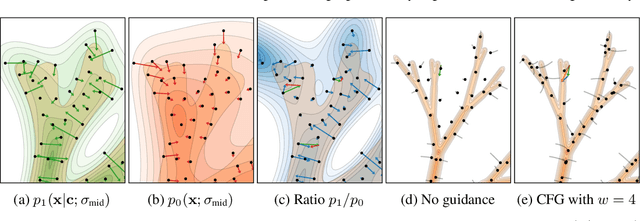

Abstract:The primary axes of interest in image-generating diffusion models are image quality, the amount of variation in the results, and how well the results align with a given condition, e.g., a class label or a text prompt. The popular classifier-free guidance approach uses an unconditional model to guide a conditional model, leading to simultaneously better prompt alignment and higher-quality images at the cost of reduced variation. These effects seem inherently entangled, and thus hard to control. We make the surprising observation that it is possible to obtain disentangled control over image quality without compromising the amount of variation by guiding generation using a smaller, less-trained version of the model itself rather than an unconditional model. This leads to significant improvements in ImageNet generation, setting record FIDs of 1.01 for 64x64 and 1.25 for 512x512, using publicly available networks. Furthermore, the method is also applicable to unconditional diffusion models, drastically improving their quality.
Applying Guidance in a Limited Interval Improves Sample and Distribution Quality in Diffusion Models
Apr 11, 2024Abstract:Guidance is a crucial technique for extracting the best performance out of image-generating diffusion models. Traditionally, a constant guidance weight has been applied throughout the sampling chain of an image. We show that guidance is clearly harmful toward the beginning of the chain (high noise levels), largely unnecessary toward the end (low noise levels), and only beneficial in the middle. We thus restrict it to a specific range of noise levels, improving both the inference speed and result quality. This limited guidance interval improves the record FID in ImageNet-512 significantly, from 1.81 to 1.40. We show that it is quantitatively and qualitatively beneficial across different sampler parameters, network architectures, and datasets, including the large-scale setting of Stable Diffusion XL. We thus suggest exposing the guidance interval as a hyperparameter in all diffusion models that use guidance.
Analyzing and Improving the Training Dynamics of Diffusion Models
Dec 05, 2023Abstract:Diffusion models currently dominate the field of data-driven image synthesis with their unparalleled scaling to large datasets. In this paper, we identify and rectify several causes for uneven and ineffective training in the popular ADM diffusion model architecture, without altering its high-level structure. Observing uncontrolled magnitude changes and imbalances in both the network activations and weights over the course of training, we redesign the network layers to preserve activation, weight, and update magnitudes on expectation. We find that systematic application of this philosophy eliminates the observed drifts and imbalances, resulting in considerably better networks at equal computational complexity. Our modifications improve the previous record FID of 2.41 in ImageNet-512 synthesis to 1.81, achieved using fast deterministic sampling. As an independent contribution, we present a method for setting the exponential moving average (EMA) parameters post-hoc, i.e., after completing the training run. This allows precise tuning of EMA length without the cost of performing several training runs, and reveals its surprising interactions with network architecture, training time, and guidance.
Projection-Domain Self-Supervision for Volumetric Helical CT Reconstruction
Dec 14, 2022Abstract:We propose a deep learning method for three-dimensional reconstruction in low-dose helical cone-beam computed tomography. We reconstruct the volume directly, i.e., not from 2D slices, guaranteeing consistency along all axes. In a crucial step beyond prior work, we train our model in a self-supervised manner in the projection domain using noisy 2D projection data, without relying on 3D reference data or the output of a reference reconstruction method. This means the fidelity of our results is not limited by the quality and availability of such data. We evaluate our method on real helical cone-beam projections and simulated phantoms. Our reconstructions are sharper and less noisy than those of previous methods, and several decibels better in quantitative PSNR measurements. When applied to full-dose data, our method produces high-quality results orders of magnitude faster than iterative techniques.
Solving Audio Inverse Problems with a Diffusion Model
Nov 08, 2022



Abstract:This paper presents CQT-Diff, a data-driven generative audio model that can, once trained, be used for solving various different audio inverse problems in a problem-agnostic setting. CQT-Diff is a neural diffusion model with an architecture that is carefully constructed to exploit pitch-equivariant symmetries in music. This is achieved by preconditioning the model with an invertible Constant-Q Transform (CQT), whose logarithmically-spaced frequency axis represents pitch equivariance as translation equivariance. The proposed method is evaluated with objective and subjective metrics in three different and varied tasks: audio bandwidth extension, inpainting, and declipping. The results show that CQT-Diff outperforms the compared baselines and ablations in audio bandwidth extension and, without retraining, delivers competitive performance against modern baselines in audio inpainting and declipping. This work represents the first diffusion-based general framework for solving inverse problems in audio processing.
Disentangling Random and Cyclic Effects in Time-Lapse Sequences
Jul 04, 2022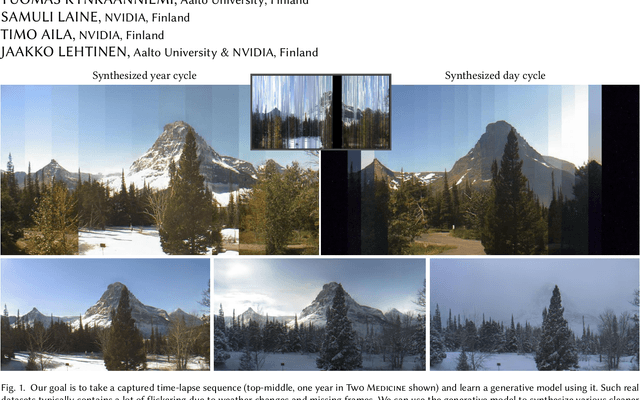
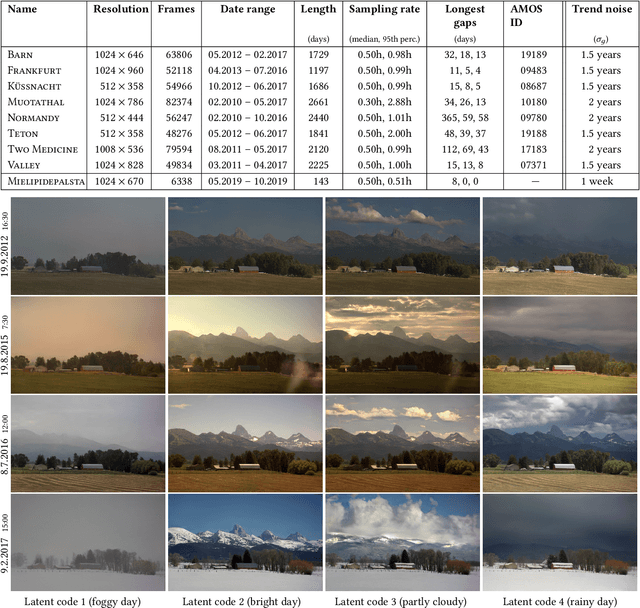
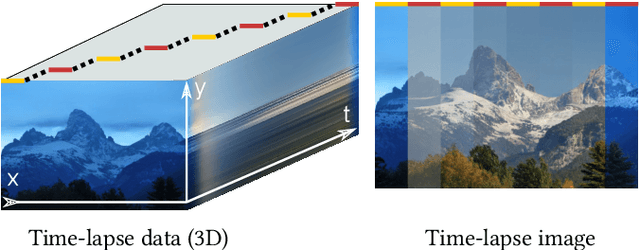

Abstract:Time-lapse image sequences offer visually compelling insights into dynamic processes that are too slow to observe in real time. However, playing a long time-lapse sequence back as a video often results in distracting flicker due to random effects, such as weather, as well as cyclic effects, such as the day-night cycle. We introduce the problem of disentangling time-lapse sequences in a way that allows separate, after-the-fact control of overall trends, cyclic effects, and random effects in the images, and describe a technique based on data-driven generative models that achieves this goal. This enables us to "re-render" the sequences in ways that would not be possible with the input images alone. For example, we can stabilize a long sequence to focus on plant growth over many months, under selectable, consistent weather. Our approach is based on Generative Adversarial Networks (GAN) that are conditioned with the time coordinate of the time-lapse sequence. Our architecture and training procedure are designed so that the networks learn to model random variations, such as weather, using the GAN's latent space, and to disentangle overall trends and cyclic variations by feeding the conditioning time label to the model using Fourier features with specific frequencies. We show that our models are robust to defects in the training data, enabling us to amend some of the practical difficulties in capturing long time-lapse sequences, such as temporary occlusions, uneven frame spacing, and missing frames.
Generating Long Videos of Dynamic Scenes
Jun 09, 2022



Abstract:We present a video generation model that accurately reproduces object motion, changes in camera viewpoint, and new content that arises over time. Existing video generation methods often fail to produce new content as a function of time while maintaining consistencies expected in real environments, such as plausible dynamics and object persistence. A common failure case is for content to never change due to over-reliance on inductive biases to provide temporal consistency, such as a single latent code that dictates content for the entire video. On the other extreme, without long-term consistency, generated videos may morph unrealistically between different scenes. To address these limitations, we prioritize the time axis by redesigning the temporal latent representation and learning long-term consistency from data by training on longer videos. To this end, we leverage a two-phase training strategy, where we separately train using longer videos at a low resolution and shorter videos at a high resolution. To evaluate the capabilities of our model, we introduce two new benchmark datasets with explicit focus on long-term temporal dynamics.
The Role of ImageNet Classes in Fréchet Inception Distance
Mar 11, 2022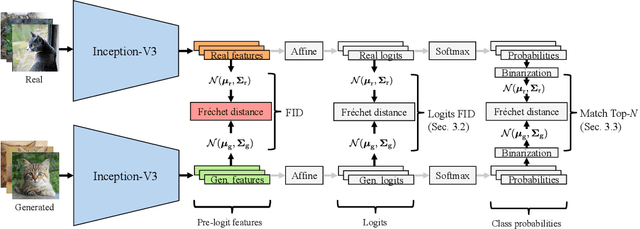

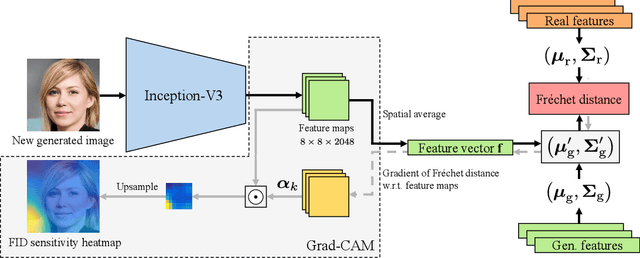

Abstract:Fr\'echet Inception Distance (FID) is a metric for quantifying the distance between two distributions of images. Given its status as a standard yardstick for ranking models in data-driven generative modeling research, it seems important that the distance is computed from general, "vision-related" features. But is it? We observe that FID is essentially a distance between sets of ImageNet class probabilities. We trace the reason to the fact that the standard feature space, the penultimate "pre-logit" layer of a particular Inception-V3 classifier network, is only one affine transform away from the logits, i.e., ImageNet classes, and thus, the features are necessarily highly specialized to them. This has unintuitive consequences for the metric's sensitivity. For example, when evaluating a model for human faces, we observe that, on average, FID is actually very insensitive to the facial region, and that the probabilities of classes like "bow tie" or "seat belt" play a much larger role. Further, we show that FID can be significantly reduced -- without actually improving the quality of results -- by an attack that first generates a slightly larger set of candidates, and then chooses a subset that happens to match the histogram of such "fringe features" in the real data. We then demonstrate that this observation has practical relevance in case of ImageNet pre-training of GANs, where a part of the observed FID improvement turns out not to be real. Our results suggest caution against over-interpreting FID improvements, and underline the need for distribution metrics that are more perceptually uniform.
Alias-Free Generative Adversarial Networks
Jul 15, 2021


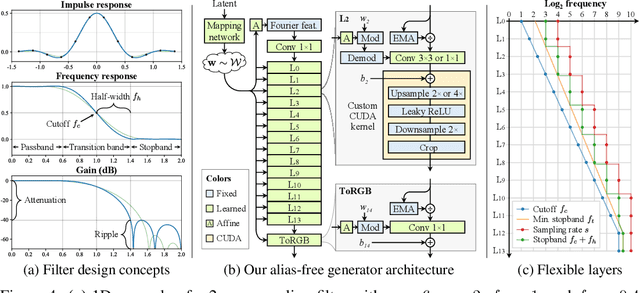
Abstract:We observe that despite their hierarchical convolutional nature, the synthesis process of typical generative adversarial networks depends on absolute pixel coordinates in an unhealthy manner. This manifests itself as, e.g., detail appearing to be glued to image coordinates instead of the surfaces of depicted objects. We trace the root cause to careless signal processing that causes aliasing in the generator network. Interpreting all signals in the network as continuous, we derive generally applicable, small architectural changes that guarantee that unwanted information cannot leak into the hierarchical synthesis process. The resulting networks match the FID of StyleGAN2 but differ dramatically in their internal representations, and they are fully equivariant to translation and rotation even at subpixel scales. Our results pave the way for generative models better suited for video and animation.
Modular Primitives for High-Performance Differentiable Rendering
Nov 06, 2020



Abstract:We present a modular differentiable renderer design that yields performance superior to previous methods by leveraging existing, highly optimized hardware graphics pipelines. Our design supports all crucial operations in a modern graphics pipeline: rasterizing large numbers of triangles, attribute interpolation, filtered texture lookups, as well as user-programmable shading and geometry processing, all in high resolutions. Our modular primitives allow custom, high-performance graphics pipelines to be built directly within automatic differentiation frameworks such as PyTorch or TensorFlow. As a motivating application, we formulate facial performance capture as an inverse rendering problem and show that it can be solved efficiently using our tools. Our results indicate that this simple and straightforward approach achieves excellent geometric correspondence between rendered results and reference imagery.
 Add to Chrome
Add to Chrome Add to Firefox
Add to Firefox Add to Edge
Add to Edge